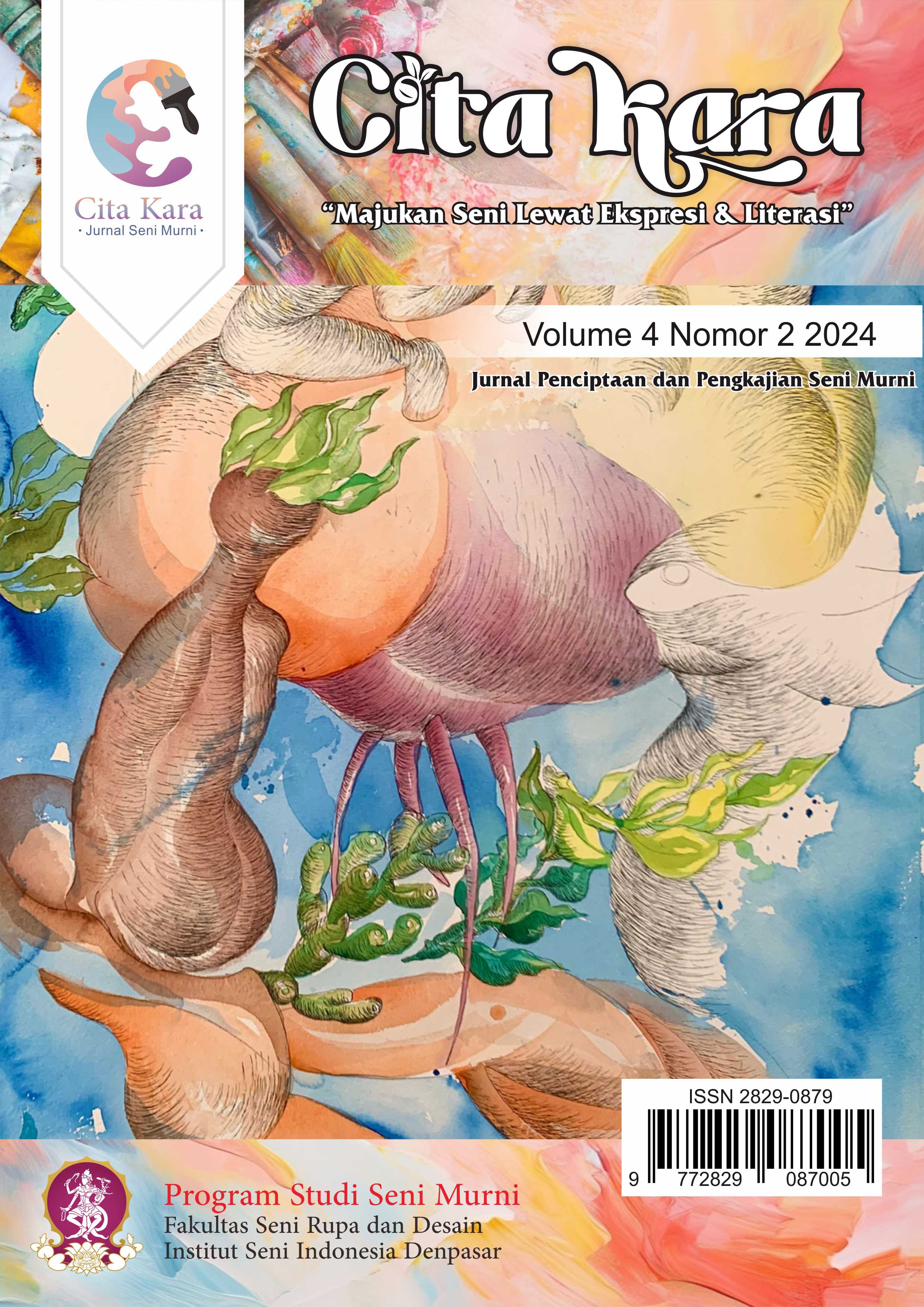The Routine of Arak Farmers in Karangasem Bali as an Idea for Creating Naturalist Sculpture Artwork
DOI:
https://doi.org/10.59997/ctkr.v4i2.717Keywords:
routine, Arak Farmer, Sculpture, NaturalistAbstract
The routine of arak farmers in Karangasem Bali is very interesting to be made an object of research on the creation of fine art (statues) with the title "Routines of Arak Farmers in Karangasem Bali as an Idea for Creating Naturalist Sculpture Art". To find out the problems of creation above, research steps, creation and presentation of art were carried out using the approach of art theory, aesthetics, construction and semiotics. The research approach uses a qualitative approach using the method of collecting observation data, interviews, documentation and literature studies. Results of the discussion: (1) the form of the statue from the representation of the routine of arak farmers in Karangasem Bali: (a) nadah tuak, (b) harvest tuak, (c) mulangin tuak, (d) ngedig lau, (e) nginum arak. (2) the technique used is the technique of adding and reducing materials. (3) the author displays the visual form of arak farmers who are carrying out daily activities or routines of the arak farmers, with a naturalistic style in each form of work emphasizing naturalness and beautifying without significantly changing the shape of the object. From this concept, 5 works were created that can be reviewed from the ideoplastic aspect and the physioplastic aspect. The output of this research is in the form of a thesis, five pieces of sculpture.
References
Dadtun, Yusana Sasanti. 2016. Minuman Keras di Batavia Akhir Abad XIX.
Yogyakarta. Ombak (Anggota IKAPI).
Dipohusodo, Istimawan. 1994. Struktur Beton Bertulang. Jakarta. PT Gramedia Utama.
Wikipedia. (2021) Arak. https://id.m.wikipedia.org/wiki/Arak_(minuman_keras) diakses tanggal 23 Maret 2021, 22:15.
https://sinta.unud.ac.id/uploads/dokumen_dir/fced3def9cebac7ec0cdce148cbbda9e.pdf diakses tanggal 23 Maret 2021, 23.00
https://www.google.com/amp/s/amp.kompas.com/travel/read/2014/09/23/2011000 27/melihat-cara-pembuatan-arak-bali-di-karangasem diakses tanggal 23 Maret 2021, 23.15
https://eproceeding.undiksha.ac.id/index.php/senadimas/article/download/1774/1177&ved=2ahUKEwjOodG6m4XyAhWGF3IKHUwGDK04ChAWMAZ6BAgCEAI&usg=AovVaw2BIOC1R3fp6AvL ZDI1tLU diakses tanggal 5 Mei 2021, 15.40
Sunarta, W. 2009. Di Bawah Lindungan Ida Bhatara Arak Api. https://balebengong.id/di-bawah-lindungan-ida-bhatara-arak-api/ diakses tanggal 5 Mei 2021, 16.00
Moleong, L. J. 2017. Metodologi Penelitian Kualitatif. Bandung: PT Remaja Rosdakarya.
Rohidi, R. T. 2011. Metode Penelitian Seni. Semarang: Cipta Prima Nusantara.
Sachari, A. 2002. Estetika Makna, Simbol, dan Daya. Bandung. ITB
Soedarso Sp. 2006. Triologi Seni Penciptaan Eksistensi Dan Kegunaan Seni. ISI Yogyakarta.
Sudjiman, P. & Art van Zoest.1992. Serba – Serbi Semiotika. Jakarta: PT. Gramedia Pustaka Utama.
Sugiharto, B. 2013. Untuk Apa Seni ?. Bandung: Pustaka Matahari.
Sugiyono. 2020. Metode Penelitian Kualitatif. Bandung: Alfabeta.
Sulistyaningsih. 2013. Perlawanan Petani Hutan. Bantul: Kreasi Wacana.
Sunarto dan Suherman. 2017. Apresiasi Seni Rupa. Yogyakarta: Thafa Media.
Susanto, M. 2011. Diksi Rupa kumpulan istilah dan gerakan seni rupa. Yogyakarta: DictiArt Lab & Djagad Art House Bali.
Wolf, E. R. 1983-1985. Petani Suatu Tinjauan Antropologis. Jakarta: CV. Rajawali.
Downloads
Published
Issue
Section
License
Copyright (c) 2024 Si Ngurah Suarsa, I Ketut Mustika, I Wayan Sukarya

This work is licensed under a Creative Commons Attribution 4.0 International License.









